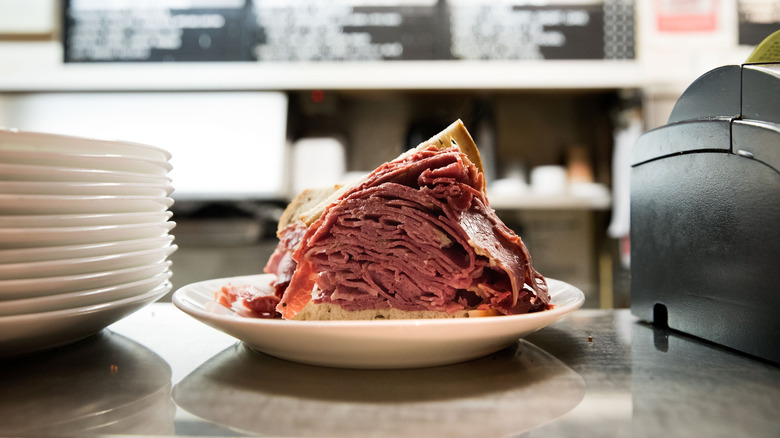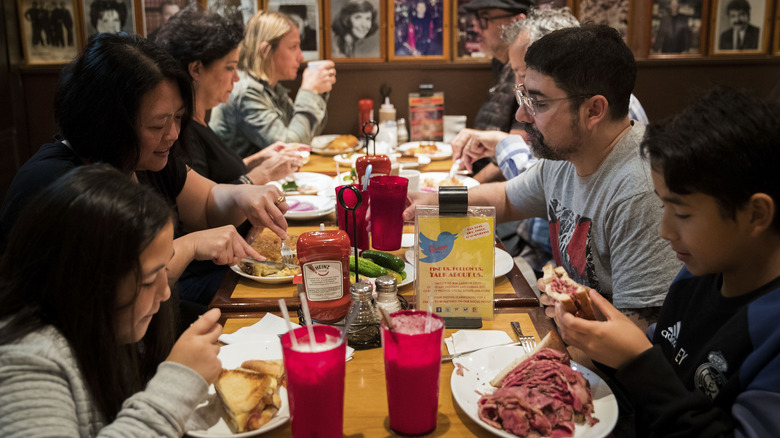The Storied History Of The Classic Jewish Deli
It's hard to imagine modern life without the beloved niche delis carved into our culture. Today the term "deli" evokes a familiar establishment with a counter, a case of cold cuts, and fast-paced service to feed today's action-packed lifestyle; delis are to eateries what convenience stores are to supermarkets. Short for the German delikatessen or French délicatesse, according to the Online Etymology Dictionary, the word "deli" originally denoted "fancy fine foods" or a place where such things were sold. So, how did the deli become so ubiquitous and associated not just with gourmands, but all kinds of busy foodies?
The answer lies with the American Jewish population. When many eaters hear the term "Jewish food," they might grasp what exactly that entails. But in fact, a huge portion of the U.S. still essentially runs on Jewish or Jewish-inspired foods every day, including bagels with cream cheese, lox, corned beef, chicken soup, dill pickles, and rugelach cookies. The history of the classic Jewish deli is inextricably tied to immigration to New York City and the impact of Jewish food traditions on the American diet.
As Jewish immigrant families from Europe traveled, they brought their foods with them, and they have since become an indispensable presence in American food culture. And while there are many Jewish delis in NYC — like Zabar's, Russ & Daughters, and 2nd Avenue Deli, to name a few — one of the most famous of them all gives us a glimpse into how Jewish deli food made it into the American mainstream.
Katz's Delicatessen, the genuine article
New York is a city built by eaters, for eaters, boasting upwards of 27,000 restaurants as of 2022, according to IBIS World. Despite the challenges presented by the COVID-19 pandemic, New York City continues to represent a diversity of cultures and cuisines with its dynamic dining scene. Part of the reason is that the city has long been a hub for immigration. According to the Library of Congress, the Lower East Side became home to scores of Jewish people from Eastern Europe in the last years of the 20th century, hosting more than 700 persons per acre by 1900 — the planet's most densely populated community.
Such a thriving neighborhood was also a hungry one in need of a familiar fixture where people could meet and eat. It was in this setting that what's now known as Katz's Delicatessen, perhaps the most emblematic example of deli culture, first opened in 1888. After changing hands and its location — admittedly just across the street, due to the inception of the subway — Katz's Deli became an institution known for its attention to detail, including its old-fashioned slow-cured beef pastrami, as Katz's asserts.
While many delis will artificially speed up the curing process, Katz's takes up to a month to produce the real deal: mouthwatering meats that attract international visitors every week. (The deli was also featured in the 1989 film "When Harry Met Sally," per Insider.) When you go, request additional bread to turn your enormous sandwich into several more.
More on Jewish cuisine
While Katz's is certainly iconic, there's more to Jewish cuisine than the deli counter. Generally, what the U.S. thinks of when it thinks of "Jewish food" is food that mainly hails from Ashkenazi, or Eastern European, communities, per My Jewish Learning. But it goes well beyond that. According to Tablet, other key components of Jewish cuisine include rye, caraway, dill, poppyseeds, and various spices and spice blends influenced by different regions where Jewish people have lived, such as Moroccan ras el hanout, Arabic za'atar, and Hungarian paprika.
Indeed, the Jewish deli foods we think of today were also influenced by the religious practice of keeping kosher, which Healthline describes as a set of religious dietary guidelines often pertaining to how animal foods are handled, processed, and eaten. Kosher guidelines also prohibit meat cuts from anything other than the forequarters. Therefore, brisket and other forequarter beef cuts feature largely on the Jewish deli menu, but American roast beef, a hindquarter cut, does not.
Unsurprisingly, many foods associated with New York City are directly linked to American Jewish cuisine. New York's bagels are widely considered the best, though they originated with Ashkenazi Jews in Poland. JSTOR Daily notes that another Jewish culinary contribution is frankfurters, which would evolve into hot dogs, another NYC staple. So the next time you order your "usual" at your favorite neighborhood deli, remember the rich history behind it and the people who helped make it a cherished part of your everyday life.


